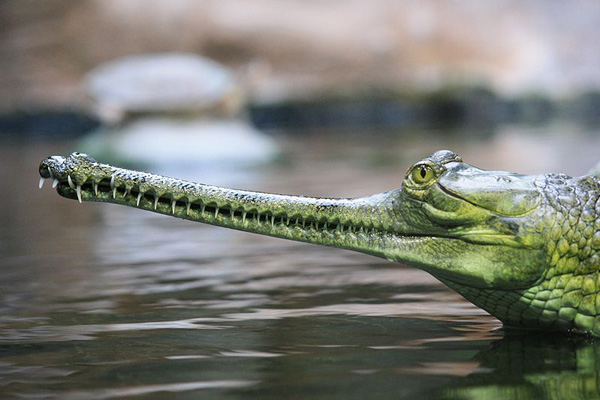Among the largest and most endangered crocodilians in the world, the gharial (Gavialis gangeticus) is on the verge of extinction today. This harmless fish-eating crocodile has fewer than 200 adult breeding individuals in the wild, their numbers having plummeted rapidly over the past few decades due to destruction of their riverine habitats, entanglement in fishing nets, and hunting. But among this gloom and doom, conservationists have been working tirelessly to reinstate the wild populations.
In one such attempt in April this year, a team from the Wildlife Trust of India (WTI) and Bihar Forest Department released six satellite-tagged gharials into a stretch of Gandak River (a tributary of the Ganges) lying between Valmiki Tiger Reserve and Sohagi Barwa Wildlife Sanctuary. The six individuals included five adult females and one male, bred in captivity at the Sanjay Gandhi Biological Park in Patna (or Patna Zoo).
“It was a great moment to see the captive bred animals going back to the wild, from a small pond at the Patna Zoo to the clean fast flowing river Gandak,” said Samir Kumar Sinha, WTI’s regional head for Bihar. “Interestingly, in India, captive breeding of gharials started with some eggs collected from the Narayani or Gandak river. The release of captive bred gharials in the same river, thus, makes the cycle complete.”

Satellite-tagged gharial released in River Gandak. Photo: Samir Kumar Sinha/WTI.
While the gharial population in the wild has remained low, it has been rising fairly rapidly in captivity. To restock the dwindling wild crocodile populations, the Indian government together with the United Nations Development Program-Food and Agriculture Organization (UNDP-FAO), launched a Crocodile Breeding and Management Project in 1975. It was under the aegis of this project that numerous rehabilitation centres were set up for gharials, and other crocodile species. Several thousand gharials were reared in captivity in these centres, and released back into the wild. Subsequently, the project was declared a success.
In 2006, however, surveys revealed otherwise. With less than 200 mature breeding gharials in the wild, their IUCN status was soon changed from Endangered to Critically Endangered. Despite a successful captive breeding program, the restocking of wild populations has yet to prove as effective.
Satellite-tagging of gharials and their continued monitoring after release could, however, help conservationists better understand their movement, habitat use, and ability to adapt in the wild.

WTI team and forest department staff with a satellite tagged gharial near river Gandak. Photo: Neha Sharma/WTI.
“The tagged animals would be satellite tracked for the next 12-18 months (based on the life of the battery in the transmitter). Other physically marked animals would be tracked manually,” said Sinha.
But for the gharials to survive in the wild, various lingering threats need to be addressed urgently. B.C. Choudhury, a senior advisor to WTI and the Regional Vicechair of the IUCN Crocodile Specialist Group, told mongabay.com, “While restocking is an active conservation action, there are lots of other disturbing causes that need to be eliminated from the riverine habitat of gharials. These include maintaining an optimal ecological flow in the rivers, stopping illegal and destructive fishing, as well as agriculture, and sand mining along the river banks that are the egg-laying areas of the gharial and many other aquatic fauna.”
For now, the six released gharials have traveled more than six miles (10 kilometers) from their release site, and have been spotted basking on the sandy river beds very close to other wild gharials in the river, according to Sinha. The team plans to continue to release gharials in the river after the monsoons.
“This will help us compare the adaptability and movement patterns of the gharials pre-and post-monsoon,” said Choudhury. “This in turn will give us an insight into our plans of initiating a similar exercise for the gharials in Bhutan, which have a sizable population in captivity, and require urgent attention for release to the wild.”

A captive Indian gharial (Gavialis gangeticus). Photo by Matěj Baťha/Creative Commons 3.0.

Satellite-tagged gharial released in River Gandak. Photo: Samir Kumar Sinha / WTI.

WTI team satellite-tagging gharial (Gavialis gangeticus) at Sanjay Gandhi Biological Park, Patna. Photo: Neha Sharma/WTI.
_(headshot).600.jpg)
Captive gharial. Photo: Justin Griffiths/Public Domain.
Related articles
Elephants in the midst: warning system prevents human-elephant conflicts in India, saves lives
(05/08/2014) Indian elephants once freely roamed the rich mid-elevation evergreen forests of the Valparai plateau in the Western Ghats, one of the world’s mega biodiversity regions, but they can’t move the way they used to. Ever-increasing commercial plantations and settlements have become obstacles to the daily and seasonal movements of elephants, creating more chances for often-deadly encounters between humans and elephants.
A sketch of the yeti: saving the Himalayan brown bear

(05/01/2014) Overall, the brown bear is one of the most widespread and numerous bear species in the world. However, a subspecies called the Himalayan brown bear is not so fortunate. It occupies higher reaches of the Himalayas in remote, mountainous areas of Pakistan, Nepal, Tibet and India. Its populations are small and isolated, and it is extremely rare in many parts of its range.
Chelonians for dinner: hunting threatens at-risk turtles and tortoises in India

(04/23/2014) The extinction risk faced by mammals is often in the limelight. But it may be surprising to learn that next only to primates, chelonians—or turtles and tortoises—are the world’s most imperiled vertebrate group. New research indicates that two such species are being threatened by hunting in the Western Ghats of India.
Kala: the face of tigers in peril

(03/27/2014) In 1864, Walter Campbell was an officer in the British Army, stationed in India when he penned these words in his journal: “Never attack a tiger on foot—if you can help it. There are cases in which you must do so. Then face him like a Briton, and kill him if you can; for if you fail to kill him, he will certainly kill you.” In a stroke of good fortune for the tiger, perceptions in India have changed drastically since Campbell’s time. Tiger hunting is now banned and conservationists are usually able to rescue the big cats if they become stranded while navigating increasingly human-occupied areas. But is this enough to save the tiger?
Europe approves vet drug that killed off almost all of Asia’s vultures

(03/25/2014) When Europeans first arrived in North America, they exterminated three to five billion passenger pigeons (Ectopistes migratorius) in the short span of a century through a combination of habitat destruction and hunting. In 1914, the last living passenger pigeon perished at the Cincinnati Zoo. Despite the staggering scale of this extinction event, three species of vulture from Southeastern Asia retain the dubious distinction of having had the most rapid population crash of any avian fauna. They might not have begun with numbers as large as the passenger pigeon, but within the space of a single decade, their populations were reduced by 96 to 99 percent.
The power of connections: India to establish Asia’s largest protected forest

(03/21/2014) India has stepped up forest conservation efforts in recent years, with a major project underway to establish a large swath of uninterrupted habitat through the designation of additional protected areas and expanding those already under protection. If realized, these areas would converge to become Asia’s largest unbroken forest, encompassing approximately 15,000 square kilometers (5,790 square miles) over three states.
Indian food giant to source deforestation-free palm oil
(03/19/2014) Orkla, a Nordic conglomerate that owns MTR Foods, one of India’s major food companies, has established a zero deforestation policy for the palm oil it sources, reports Greenpeace.
Can the millions in urban India live among greenery?

(03/06/2014) Large swathes of wilderness alternating with pockets of urbanization may be a reality in some countries, but in India boundaries are soft. Where a city ends and where a village begins in its outskirts is somewhat fuzzy. Rapidly developing megacities like Bangalore and Pune, localities like Gurgaon outside New Delhi, have been subsuming surrounding villages into their ever-expanding boundaries for the last couple of decades.

(02/25/2014) In May 2011, a young male Bengal tiger (Panthera tigris tigris) made its way to a village in the state of Karnataka in India. The tiger had been quite a hiker. To reach the village, it had walked more than 280 kilometers (174 miles) from Bandipur Tiger Reserve, a protected area famous for these elusive big cats.















